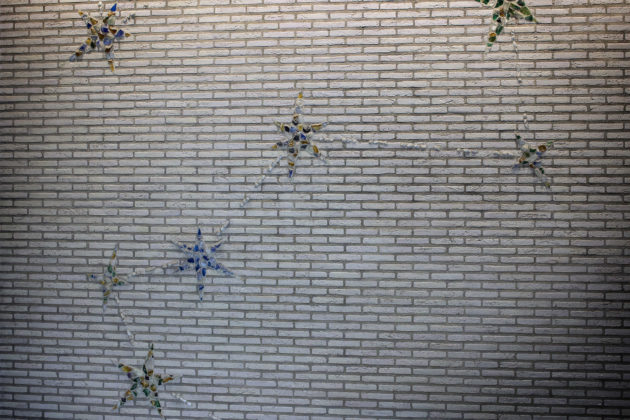
Stories behind art at the RUG
The painting that hung upside down
The Dragon
Wladimir de Vries
Location: Academy building
There’s a dragon in the Academy building. You probably never noticed it, because it’s well-hidden. Go past the Geertsemazaal, down the stairs to the Zernikezaal, and there it is. If you don’t immediately recognise it as the mythical fire-breathing creature, don’t worry: it’s not a real dragon, but rather a glass mosaic of the Chinese zodiac sign of the same name.
Han Borg, former president of the RUG’s Art Committee, didn’t discover the work for years. Somewhere in 1989, an elderly man and his daughter approached him, asking where they could find the dragon in the Academy building. The man turned out to be Wladimir de Vries, the artist who’d made the piece almost forty years before that.
‘But not even he could remember whether he’d made a statue or a mosaic’, says Borg, chuckling. ‘We walked around looking at several pieces, but we couldn’t find it.’ After asking around, Borg found a building manager who remembered the piece De Vries was looking for and where it was.
Borg felt it was a shame that there was artwork that no one could remember. It led him to found the Art Committee. ‘I want to literally and figuratively shine a spotlight on the art at the university.’
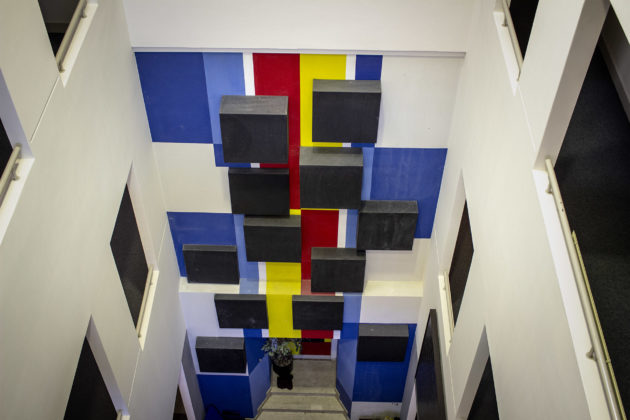
Object in yellow, red, and blue
Siep van den Berg
Location: Oude Boteringestraat 34
Cool, the university said in 1975: we’ll have well-known Groningen artist Siep van den Berg make a mural for the art history building. But in the nineties, the university scheduled extensive renovations, and the wall with the mural on it was scheduled to make way for a stairwell and elevator. The board of directors was fine with this, but Bernhard Ridderbos, an art history lecturer at the time, wasn’t.
‘That mural had been there since before I was a student’, Ridderbos recalls. ‘I hated that they wanted to destroy it. How could an institute for art history casually get rid of such an important piece?’
He started a petition. ‘We collected quite a few signatures, and presented them to the board. They never actually responded to us, but we felt like heroes nevertheless.’
Artist Van den Berg also took action, and actually got results: he sued the university. The university won, but when Van den Berg appealed, he was victorious. The design for the renovation was changed and the wall remained. Walking up the stairs, you can’t miss it – it almost reaches to the ceiling.
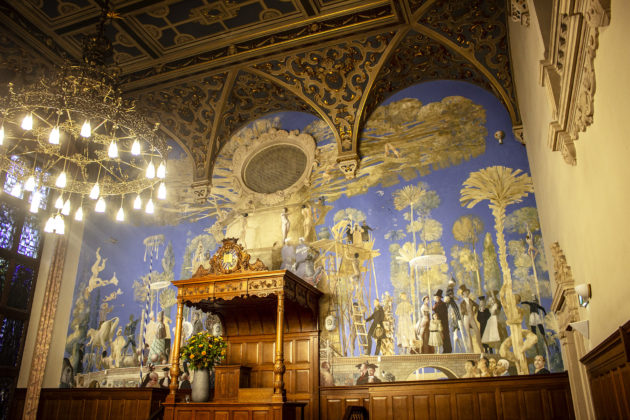
Tree of Knowledge
Wout Muller & Matthijs Röling
Location: Academy building auditorium
If you’re at the Academy building auditorium for a PhD ceremony or a lecture, you might get distracted by the giant fresco behind the podium: a circus of people surrounding the Tree of Knowledge. Some of them are trying to climb the tree; a reference to pride.
The piece, painted by Wout Muller and Matthijs Röling in 1987, contains more such references. In the lower right corner, they painted Henk van Os, their patron. Next to him we find Groningen professor Bert Röling, Matthijs’ father. He represented the Netherlands in the tribunal that tried Japanese war criminals after the Second World War, which explains the group of Japanese people beside him.
Ome Loeks’ peerd is also depicted on the fresco, all the way to the left. He’s hard to miss, since his giant behind is facing the viewer. Next to him is a figure in black robes. This is the poet Jean Pierre Rawie, a friend of the painters. ‘They thought he could die at any moment, since he was severely depressed at the time’, says Han Borg. Fortunately, Rawie recovered.
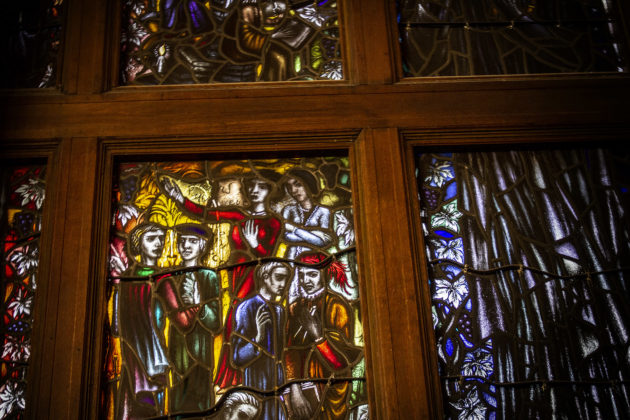
Stained-glass windows
Johan Dijkstra
Location: Auditorium and Academy building stairwell
If you’re tired of the Tree of Knowledge, all you have to do is turn your head for a new view: three lavish stained-glass windows. The middle one was gifted to the university by Queen Wilhelmina, who received an honorary doctorate in 1914.
The panels depict various events and figured from the history of Groningen and the university. The window on the right depicts Aletta Jacobs, flanked by Anda Kerkhoven. Anda was a medical student just like Aletta, but she is a lot less well-known. She came to the RUG from Batavia in 1938, because animal testing wasn’t mandatory here.
Her studies were going well, but when the war broke out, she joined the resistance as a courier. She was picked up by the Sicherheitsdienst in 1944 and tortured in the infamous Scholtenhuis. She was executed near Glimmen when she was twenty-five years old, less than a month before Groningen was liberated.
Leaving the auditorium, you run into Ubbo Emmius in the stairwell; he was the university’s first rector magnificus. The stained-glass windows next to him depict theology law, medical sciences, and philosophy: the university’s first four faculties. There’s also a spot for Minerva, the patron saint of science.
‘These windows were delivered when the third and current Academy building was finished’, says Han Borg. ‘That was in 1909, three years after the second building burned down. People were upset by the windows, especially the professors. What was this? These old, classical windows that they used to have in the Middle Ages? They thought they were awful!’
The old style didn’t match the new Academy building, which they said should be modern, innovative. These stained-glass windows belonged in a church, not a progressive academy building. Borg: ‘Especially Huizinga, a history professor, got really upset.’ It was all to no avail: a hundred years later, the windows are still there.
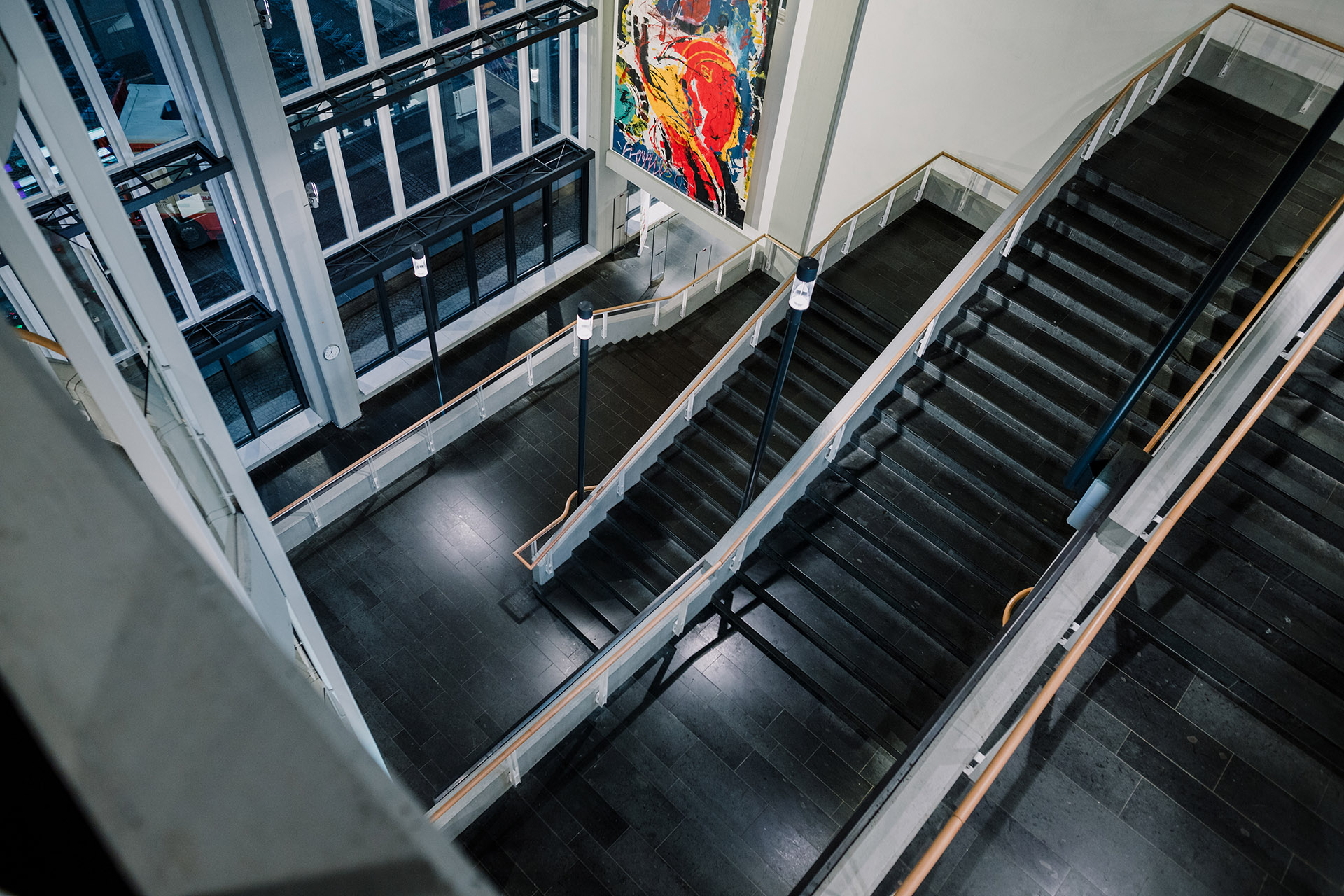
Unnamed
Gerriet Postma
Location: Stairwell University Library
You can’t miss this colourful painting at the UB stairwell, as it’s fifteen metres high. It’s from Groningen artist Gerriet Postma and was painted in 1997. The university’s had it for twenty years, but it wasn’t always there; an abstract piece by Ruud van der Wint adorned the stairwell before it. This was a large blue panel with a yellow circle. It had been hanging there since 1987, but unfortunately, it was upside down. Nobody noticed this until Van der Wint himself dropped by and noticed the mistake.
Van der Wint’s piece had to be moved due to renovations and couldn’t be returned since it would be right below a ventilation unit. It’s currently in the Groningen Museum warehouse, waiting for a new destination.


